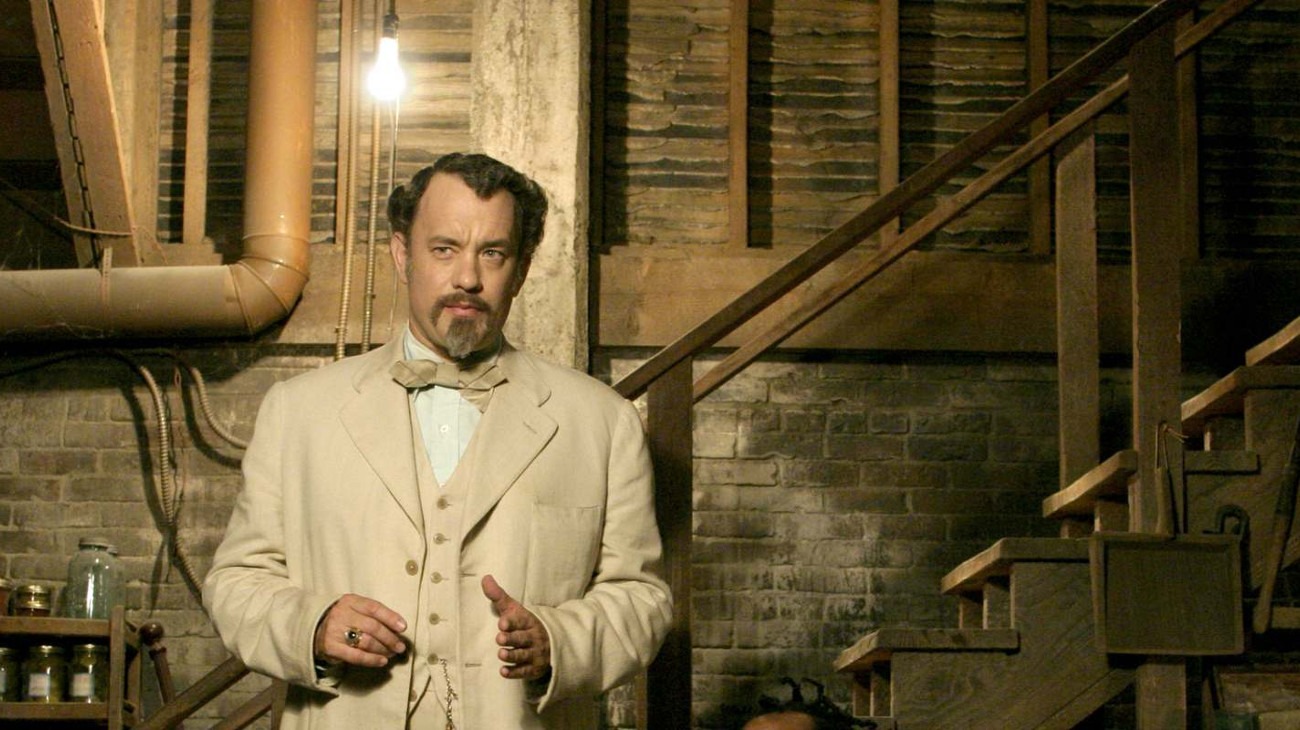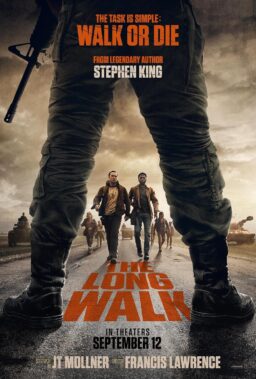“The thirst for knowledge is a very commendable thing. Though I do believe that when you hear the explanation you shall laugh riotously, slappin’ your knee and perhaps even wipin’ away a giddy tear, relieved of your former concern.” When Tom Hanks as the loquacious conman Goldthwaite Higginson Dorr Ph.D attempts to explain to his host, the devout widowed church lady Marva Munson (Irma P. Hall), why an earth-shaking explosion has occurred in her basement—he does so with the unwavering gusto that epitomizes the genteel eccentricity of this maniacal character. Hanks stumbles, guffaws, lies, and orates through a role that would be a tasteless caricature if it weren’t so wickedly funny.
You’re also reminded of how wonderful it is when Tom Hanks is weird. So much of his amiable persona has been built on his seeming normalcy: He isn’t an actor blessed with conventional leading man looks and doesn’t appear to devote himself to a grueling actorly code. He specializes in presenting—even though we know what we see on screen probably isn’t the real him—a portion of himself that feels as natural, authentic, and relatable as any family member. So when he goes weird, there is a startling unraveling of an easygoing performer into a hardened workman, pushing himself to the limits of his range.
Twenty years ago, in 2004, he might have had the strangest year of his career. Hanks starred in “The Ladykillers,” “The Terminal” and “The Polar Express—three roles where he tried his hand at being an oddball chameleon, only to hone a talent for finding the essence inside incongruous characters that would ultimately fuel the second half of his career.
In Joel and Ethan Coen’s remake of the same-titled 1955 Ealing British comedy, the Professor appears on Marva’s porch brandishing a Cheshire cat grin. He is the anti-Mary Poppins, sweeping in on the warm Southern wind with ill intent. The South has always been ripe ground for tricksters: Mark Twain’s Huckleberry Finn, Br’er Rabbit, Foghorn Leghorn (to be clear, racist stereotypes have also historically reduced Southern Blacks into shifty characters) form the crux of the region’s mischievous pop culture tradition. When the Professor arrives in his white capelet coat quoting Edgar Allan Poe, he is simply a new addition to the off-kilter setting. It’s why the charitable Marva takes the Professor in so easily, setting in motion a bumbling heist that puts all of Hanks’ comedic sensibilities—his broadness and his penchant for hamming it up—on display.
“The Ladykillers,” nonetheless, is considered by many to be the Coen Brothers’ worst film. “There are too many moments where dialogue seems so unmatched to the characters that they seem to be victims of a drive-by ventriloquist,” wrote Roger Ebert of the film. “Grounded in caricature and played for loud, unmodulated laughs, the film suffers from the same problems that affected the Coens’ other big dud, The Hudsucker Proxy—namely, little fun and no heartbeat,” added Manhola Dargis for her review for the LA Times. At the time of filming, Hanks made the decision not to watch the original for fear of defaulting to its choices. “The last thing I would have wanted was to have seen the film and have it censoring me and making me inadvertently imitate the great Alec Guinness. There’s a reason why he’s ‘Sir’ Alec Guinness,” explained the actor.
The film frames the Professor as a charlatan from the start: Through his melodiously affectatious accent—Hanks tightens the corners of his lips to achieve the intonation—he explains that he teaches at the University of Mississippi in Hattiesburg. His doctorates were conferred for his aptitude in Greek and Latin, and he holds other advanced degrees, including the “baccalaureate from a school in Paris, France, called the Sorbonne,” he explains. Tellingly, he perpetually quotes the only verse he appears to have memorized: Poe’s “To Helen.” He wants to stay in Marva’s spare room and use her basement, ostensibly to practice with a Renaissance period ensemble whose vintage is no more recent than the Rococo. In reality, his “band” is a ragtag group of thieves hoping to tunnel from Marva’s home to a not-too-distant casino’s vaults.
Hanks has often professed that he doesn’t play villains well. But the tension of Marva’s town—the unspecified corner of Mississippi is an oppressively sunny region populated by a prototypically rapturous church and the listless law by day, yet is a haunting, foggy Gothic hamlet by night—perfectly juxtaposes the All-American star persona Hanks previously cultivated with the wicked new clothes he’s trying on for size here. The role, of course, is also a return to his lighthearted roots in broad comedies like “Big,” “Turner and Hooch,” and “The Burbs.” The alchemy Hanks conjures in “The Ladykillers,” therefore, is a fascinating brew of an actor taking the recognizable portions of himself to create a version that is remarkably new.
This reconfigured model of Hanks is on gleeful display in the second half of “The Ladykillers.” Following the explosion in her basement, Marva ambles downstairs to discover the Professor and his criminal cohort attempting to catch the casino loot now floating in the air. “Professor, I’m surprised,” recoils Marva. “Properly speaking madam, we are surprised,” retorts the Professor as he quickly reaches for another dollar bill landing close to him. “You are taken aback.” Hanks stands slightly bent, a welcoming stance that belies his cracked smile. “Though I do acknowledge the sense that you intend is gaining currency,” he continues, snapping cash between his hands as he mulls the thought. To soothe Marva, the Professor makes up an outlandish story, told with side-splitting brazenness, of a search for an arrowhead leading to a collision with a natural gas line that blew up a nest egg belonging to one of the criminals. Hanks is devilishly intoxicating. His bulging eyes grow larger with every mounting lie; his grin more askew with every mistruth. When fibbing doesn’t work, the Professor attempts to bribe Marva. When that avenue leads to a deadend, he enlists his lawbreaking band to murder her. Each attempt fails, culminating in a revealing scene on the bridge. Lump Hudson (Ryan Hurst), the dumb muscles of the group, defies the Professor: He will not murder Marva. His resistance causes the Professor to drop his genteel mask. A scoundrel appears in his place, one who has clearly murdered before and will do so again. Hanks has rarely been more vicious. “You stupid boy. You very, extremely, stupid boy,” he spits as his body shakes and his teeth somehow turn more crooked. Hanks has somehow shrunken himself to be a rat. We hate him for it, and applaud when his lifeless body joins the garbage barge that traverses this town’s river.
When seeing how well Hanks leverages villainy for laughs, it’s fascinating to consider that Hanks doesn’t believe he plays bad guys well. “I can never understand them, because antagonists, in general, require a certain degree of malevolence that I can’t fake,” he revealed to The New York Times. Maybe that explains why after “The Ladykillers” Hanks didn’t go on a run of playing morally corrupt characters. Instead, he immediately followed up it with “The Terminal,” a film that in many ways leans on his strengths.
For one, it was a repairing of Hanks and Spielberg—a sturdy partnership that up to that point included “Saving Private Ryan” and “Catch Me if You Can.” The role of Viktor Navorski, a traveler from Krakozhia, confined to JFK Airport due to an ongoing civil war in his country, is a prototypical Hanksian figure. Navorski is the common man thrown into extraordinary circumstances; affable and determined, morally firm amidst immoral characters—in this case Acting Field Commissioner Frank Dixon (Stanley Tucci) tries every nefarious method to evict Navorski from the airport— this Hanks character is easy to love. He has arrived in New York City with a can of planters peanuts that holds a dying wish: He promised his deceased father that he would arrive in the big apple to obtain the final signature from one of his jazz heroes Benny Golson. During his confinement Navorski grows romantically close with Flight Attendant Amelia Warren (Catherine Zeta-Jones) and forms unshakeable bonds with the airport’s large cast of characters.
It’s a role, however, that asked Hanks to once again craft an accent. While Hanks routinely does passable work with Southern dialects, such as “The Green Mile,” “Forrest Gump,” and, surprisingly, “The Ladykillers,” he often struggles with other regions and countries. No more so than in “The Terminal.” His mangled Eastern European tones include rolling R’s that are knotted into his regular speaking voice. The film’s meandering plotting also matches Hanks’ tangled prose. And yet, I personally can’t help but be taken by the emotional heft of Hanks’ turn.
It’s a feeling most deeply felt in the aching reveal shared by Navorski and Warren. “So what am I seeing,” Warren asks Navorski, having just learned that he is not a delayed business traveler but a man without a country. “Who are you,” she further prods, “Unacceptable?” As Navorski, Hanks is kinetic. He relies on swinging hand gestures, his head slightly bowed to suggest meekness. When Warren attempts to storm away, his long, exaggerated strides work to catch up to her. He leads her to the mosaic fountain he’s built for her, a nod to Napoleon’s gift to Josephine after conquering Bavaria. But the gesture is not enough. He must come out with the full truth. Spielberg opts for low-key lighting as Navorski—his hands clasped, his body slightly leaning forward—explains his mission to get these jazz signatures. Spielberg then cuts to a two shot of Warren on one side and Navorski on the other, back lit by the fountain. The shot accentuates their silhouettes, calling attention to Hanks’ explanatory hand gestures. A close-up sees Navorski, one by one, pulling out the signatures: Scribbled on photographs, coasters, and other club ephemera. Navorski stands up, moving closer to the fountain. “What are you waiting for,” asks Warren. “I’m waiting for you,” responds Navorski with such earnestness that Warren must kiss him.
For my money, the romantic pairing of Hanks and Jones doesn’t wholly work. Mostly because Warren is underwritten. But the surprising success of their lovestruck scene teases a lesson learned by Hanks. It’s not enough to perform mimicry, as he did in “The Ladykillers.” There needs to be an essence for the audience and the actor to latch onto. In this scene, he ceases to play Navorski the caricature. He plays Navorski the human.
Hanks continued to test the boundaries of impersonation in his third 2004 film: Robert Zemeckis’ unhinged nightmare fueled animated Christmas flick “The Polar Express.” Similar to “The Terminal,” “The Polar Express” once again witnessed Hanks reteaming with a director he previously had considerable success with. The actor and director’s first partnership, “Forrest Gump,” netted Hanks his second straight Best Actor Oscar; their second teaming, “Cast Away,” might be the actor’s best performance of his career. But a weird, ungodly concoction happened with their first foray into motion capturing (a technology Zemeckis would become slavishly addicted to on “Beowulf,” “A Christmas Carol,” and “Welcome to Marwen”). The results of which have continued to fuel online humor.
In “The Polar Express,” Hanks does voicework for six different characters. He is first heard in the opening scene as the adult narrator of this story looking back at his childhood. Known as Hero Boy, this is a kid whose belief in Santa is so diminished, he needs this fateful night to reignite his sense of wonder. Hanks also plays Hero Boy’s father, who laments his son’s disillusionment. As Hero Boy lies in his bed on Christmas Eve, awaiting the next day, the magical Polar Express pulls outside his house. Its conductor, also voiced by Hanks, punches the kid’s golden ticket to the North Pole. The journey to Santa’s workshop is filled with plenty of obstacles won over by Hero Boy’s pure spirit: He helps Hero Girl (Nona Gaye) with her ticket, gives a lonely kid (Peter Scolari) the courage to step aboard the locomotive, and even helps Santa with his sleigh.
“The Polar Express” marked a return to animation for Hanks, and remains his most expansive voice work outside of the “Toy Story” franchise. Next to “Cloud Atlas,” a film where he similarly played several different characters, it’s the film that probably put the greatest strain on his own abilities. “There’s only so much that I can internally grasp as an actor,” he explained to IGN. “And on the day of tests that we did I played five or six or seven roles in the course of that day, and I said, ‘Bob, I’m exhausted here.’ So in my mind, I had a track on the five characters that I played.” In the same interview, the actor further talked about why the experience of motion capturing, nevertheless, felt so familiar: “It was exactly like rehearsing a play in the round. You don’t have to worry about lights, angles, rails, cameras, over the shoulders coverage. We essentially did a great series of 10 or 15 minute plays in which we did it real, we did it all in real time, and when we were done Bob had everything that he needed. So, as far as being an actor goes, it was a blast.”
The results on screen for viewers, of course, does not match the astonishment Hanks felt while filming it. None of the animation has aged particularly well. The color palette is far too glossy, the kids’ hairstyles are as frozen as bad toupees, their facial expressions are blank, their eyes are dead, and they move robotically. It all looks like an animatronic revolt that began in Disneyland and ended in Chuck E Cheese. Some of these kids look so ghoulish in their uncanny valley, it causes much of the film’s intended charm to wither.
Having said that, the picture’s downfall wasn’t solely due to its appearance. Hanks simply doesn’t rise to the occasion. He strains to modulate his voice to encompass the wide range of impersonations required for the fantasy adventure. His limits are partly felt in his invocation of Santa Claus—his muffled voice sounds like he’s chewing marbles—and is most glaring as the train’s magical hobo. The target Hanks is aiming for as the hobo is unclear. It’s a broad, theatrical mix of a noir, Jersey accent that alludes consistency and delight. Hanks’ failure here arises from his varied vocal performances lacking the emotional rigor found in “The Terminal” and in his other animated turn as Woody in “Toy Story.” It’s a startling misstep that recalls what Justin Chang observed for the LA Times wrote about Hanks during the release of Baz Luhrmann’s “Elvis.” “The performances, like the movie itself, are a mixed but ambitious bag, and at their best they suggest something of what must have drawn Hanks to Hollywood in the first place: not the chance to play paragons of working-class virtue, but rather a sense of acting as play, as a form of liberating, exhilarating make-believe,” explains Chang of Hanks’ bold swing with “Cloud Atlas.”
Thinking about Hanks’ performances in “The Ladykillers,” “The Terminal,” and “The Polar Express” illuminates how the actor might have taken these experiences to inform his later turn to biopics. Fascinatingly, prior to “Catch Me If You Can,” in a role loosely based on Joseph Shea, Hanks had only played a real life person once in Ron Howard’s “Apollo 13.” Over the last two decades, however, he has played Senator Charlie Wilson, Captain Richard Phillips, Walt Disney, attorney James B. Donovan, Captain Sully, Ben Bradlee, Mister Rogers, and Colonel Parker. Few of these roles could be defined as total transformations. Nearly all of them, with the notable exception of Colonel Parker, retain the kind of down-to-earth, everyman spirit that has become Hanks’ calling card. Rather the best way to analyze these performances is to reconsider what Hanks learned from his perceived failure as a villain in “The Ladykillers” and his success in “The Terminal.”
With these real people, Hanks isn’t necessarily performing mimicry. If one matches his take to the reality of these characters’ actual existence, we find that he scarcely projects a mirrored image. In some cases, like Mister Rogers, he doesn’t even look like the subjects. On a cinematic landscape that prizes immersing yourself into a role to the point of becoming the subject’s twin, what Hanks accomplishes is the lifeblood of acting. He is latching onto the essence of the character, playing the tometic meaning of their human lives for palpable emotion.
It’s worth noting that twenty years after “The Ladykillers,” Hanks is once again on an odd streak. Three of his last four films: “Elvis,” “A Man Called Otto,” and “Asteroid City”—see him portraying men propelled by cynicism rather than a belief in the innate goodness of the world. Similar to his rough stretch in 2004, these attempts have delivered mixed results. Still, for anyone worried that Hanks is entering a marked downturn, all they need to do is hope history repeats itself. If the miss that was “The Ladykillers” says anything, this latest turn to weird might be kicking off a rich next phase in Hanks’ distinguished career.












